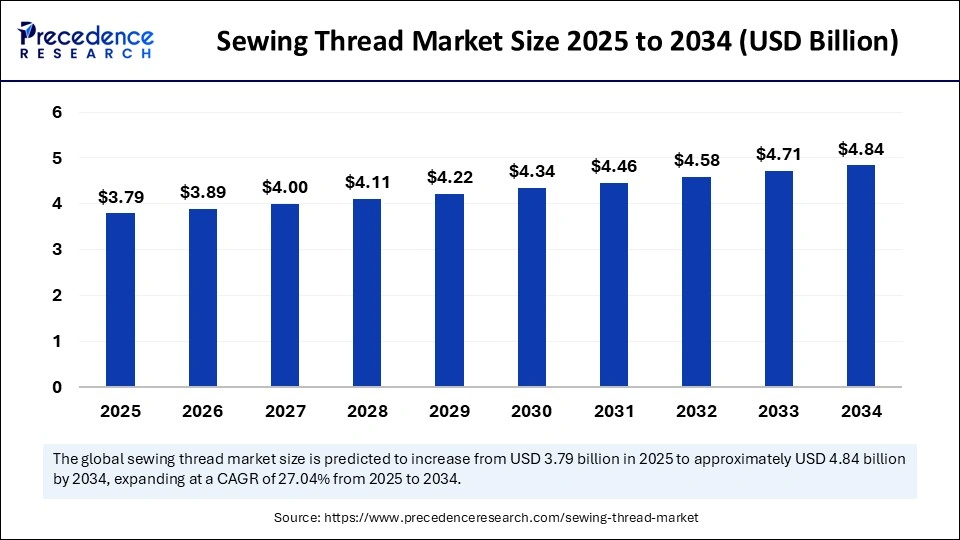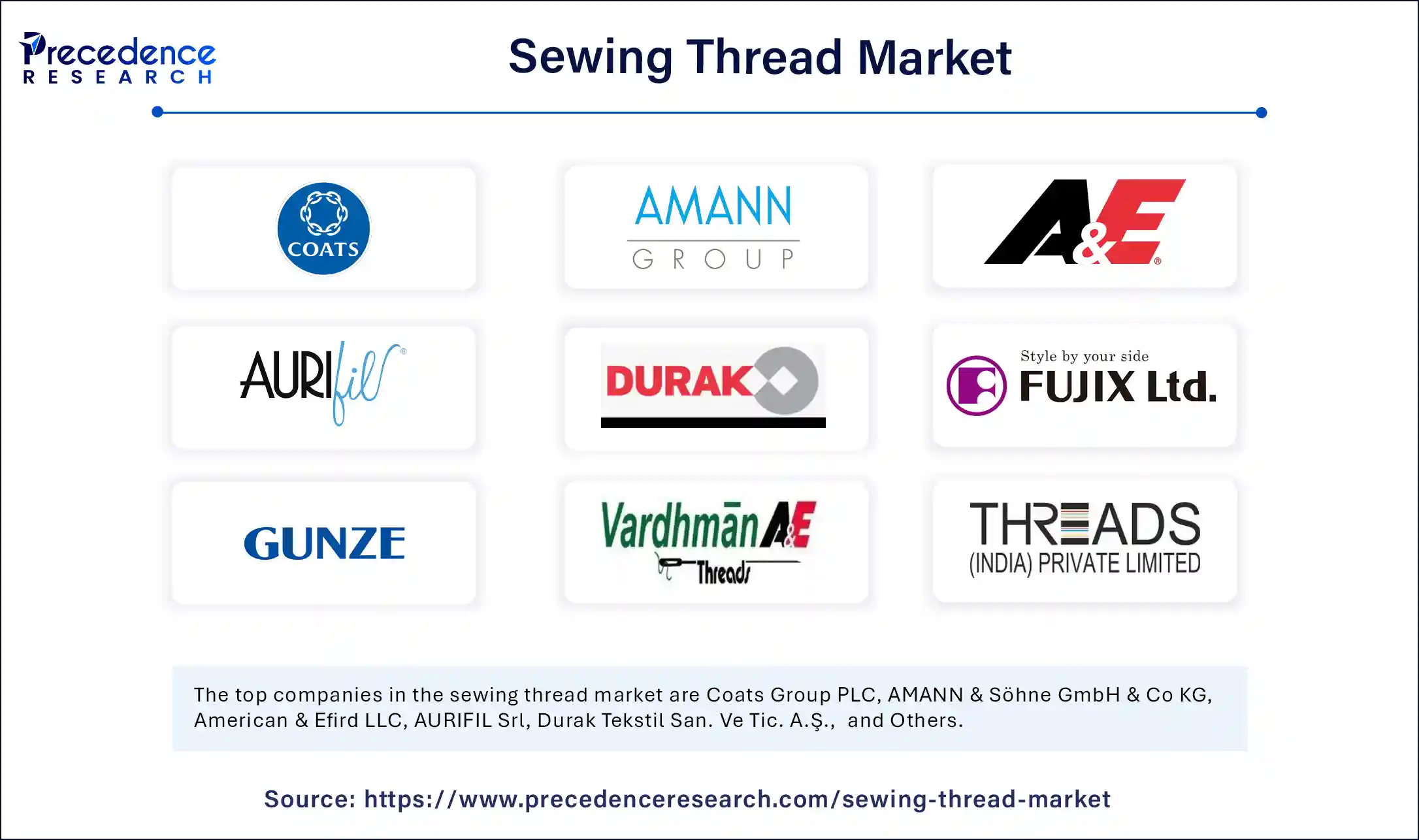The global sewing thread market size is estimated to attain around USD 4.84 billion by 2034 increasing from USD 3.69 billion in 2024, with a CAGR of 2.74%.

Sewing Thread Market Key Points
-
Asia Pacific dominated the global market with the largest market share of 48% in 2024.
-
North America is anticipated to grow at the fastest CAGR during the forecast period.
-
By application, the apparel segment held the major market share in 2024.
-
The footwear segment is expected to witness the fastest growth during the predicted timeframe.
-
By type, the synthetic segment captured the biggest market share of 61% in 2024.
-
The natural segment is expected to grow at the fastest CAGR in the upcoming years.
-
By distribution channel, the specialty stores segment held a major market share of 37.20% in 2024.
-
The online sales segment is expected to grow at a significant CAGR over the projected period.
Sewing Thread: Essential Material for Textile and Garment Manufacturing
Sewing thread is a fundamental component in the textile and garment industries, used to stitch fabrics together in clothing, upholstery, and various textile products. It is available in different materials such as cotton, polyester, nylon, and blended fibers, each offering specific strength, elasticity, and durability suited for various sewing applications. The quality and type of thread directly impact the appearance, strength, and longevity of the final product.
The sewing thread market is expanding globally due to rising demand in apparel production, home textiles, and industrial uses. Innovations such as eco-friendly and high-performance threads are gaining traction as sustainability and advanced fabric technologies become priorities. Regions with large textile manufacturing hubs, like Asia-Pacific, dominate the market, driven by growing fashion industries and increasing consumer preference for durable and quality garments.
How Is AI Influencing the Sewing Thread Market?
Artificial Intelligence (AI) is playing an important role in modernizing the sewing thread market by optimizing production processes and enhancing quality control. AI-powered systems analyze data from manufacturing lines to monitor thread strength, consistency, and texture in real time, reducing defects and waste. This leads to higher efficiency, better product quality, and cost savings for manufacturers.
Additionally, AI supports innovation in product development by predicting market trends and consumer preferences, enabling companies to create specialized threads tailored for specific applications such as technical textiles or smart fabrics. AI-driven supply chain management also helps streamline inventory, demand forecasting, and distribution, making the sewing thread market more responsive and competitive.
Get Sample Copy of This Report@ https://www.precedenceresearch.com/sample/6151
Market Overview: Essential Component in Textile and Apparel Industries
The sewing thread market plays a fundamental role in the textile and apparel industries, providing the essential stitching material used in garment manufacturing, upholstery, home textiles, and industrial applications. Sewing threads are made from various raw materials including cotton, polyester, nylon, and other synthetic fibers, each offering distinct qualities suited to different end-uses. Over the years, the market has evolved with technological advancements in thread production, introducing specialty threads such as fire-retardant, elastic, and water-resistant variants that cater to diverse industrial needs. As global demand for apparel, footwear, and home furnishings grows, the sewing thread market remains a critical underpinning of these sectors, supporting both mass production and specialized craftsmanship. Sustainability trends are also encouraging manufacturers to explore eco-friendly and biodegradable threads, aligning with the larger movement toward green textiles.
Sewing Thread Market Growth Factors
Several key factors are propelling the growth of the sewing thread market globally. The most significant among them is the rising demand for ready-made garments driven by urbanization, changing fashion trends, and increased disposable incomes, particularly in emerging economies. The surge in fast fashion and e-commerce has further accelerated apparel production cycles, increasing the need for reliable and high-quality sewing threads that can withstand varied manufacturing processes. Technological advancements in thread manufacturing, such as improved spinning techniques and blending of fibers, have enhanced thread strength, durability, and elasticity, thereby expanding their applications beyond conventional uses. Additionally, the increasing use of automated sewing machines in garment factories is boosting demand for uniform, high-performance threads that minimize breakage and downtime. The adoption of specialty threads with enhanced properties also supports growth in niche sectors such as automotive textiles and medical textiles.
Market Scope
| Report Coverage | Details |
| Market Size by 2034 | USD 4.84 Billion |
| Market Size in 2025 | USD 3.79 Billion |
| Market Size in 2024 | USD 3.69 Billion |
| Market Growth Rate from 2025 to 2034 | CAGR of 2.74% |
| Dominating Region | Asia Pacific |
| Fastest Growing Region | North America |
| Base Year | 2024 |
| Forecast Period | 2025 to 2034 |
| Segments Covered | Application, Type, Distribution, and Region |
| Regions Covered | North America, Europe, Asia-Pacific, Latin America, and Middle East & Africa |
Sewing Thread Market Dynamics
Key Market Drivers: Fashion Industry Dynamics and Industrial Expansion
The sewing thread market is primarily driven by the booming fashion industry, which demands continuous innovation in textile materials and sewing solutions. Apparel brands and manufacturers seek threads that not only provide strength and durability but also contribute to the aesthetic appeal of garments, such as threads with vibrant colors and special finishes. The expansion of industrial applications, including upholstery, footwear, and technical textiles, further stimulates demand for specialized threads tailored to these sectors’ unique requirements. Regulatory emphasis on workplace safety and product standards is also encouraging the use of high-quality threads that ensure garment integrity and consumer safety. Moreover, the global rise in the DIY (do-it-yourself) culture and home sewing hobbies is creating additional demand for sewing threads in retail and craft sectors, expanding the market reach.
Opportunities: Sustainable Threads and Emerging Markets
The sewing thread market holds significant opportunities in the development and adoption of sustainable and biodegradable threads, responding to increasing consumer awareness and regulatory pressures for eco-friendly textile products. Innovations in bio-based fibers and recycled materials present promising avenues for manufacturers to create threads that reduce environmental impact without compromising performance. Expanding apparel manufacturing hubs in regions such as Southeast Asia, Africa, and Latin America provide fertile ground for market expansion, especially as local industries mature and modernize their production capabilities. Additionally, growth in specialized end-use sectors such as automotive textiles, medical textiles, and protective clothing opens new avenues for customized thread products designed to meet stringent performance criteria. Digital printing and smart textiles represent future trends that may integrate with sewing thread technologies, enabling multifunctional and interactive garment features.
Challenges: Raw Material Volatility and Competitive Pricing
Despite robust growth potential, the sewing thread market faces several challenges that may impede expansion. Raw material price volatility, particularly for cotton and synthetic fibers, can significantly affect manufacturing costs and profit margins. The dependence on petroleum-based raw materials for synthetic threads also exposes the market to fluctuations in oil prices and supply chain disruptions. Intense competition among manufacturers often leads to price wars, especially in commoditized segments of the market, which can undermine profitability and drive smaller players out. Quality inconsistency and counterfeit products in certain regions pose challenges to brand reputation and consumer trust. Additionally, the market must navigate regulatory hurdles related to environmental compliance, chemical usage, and labor standards, which can increase operational costs and require ongoing investment in sustainable practices.
Regional Outlook: Asia-Pacific Leads, with Growing Demand in Americas and Europe
Asia-Pacific dominates the sewing thread market due to its position as the global hub for textile and apparel manufacturing, led by countries such as China, India, Bangladesh, Vietnam, and Indonesia. The region benefits from abundant raw material availability, competitive labor costs, and strong export-oriented garment industries, which collectively fuel steady demand for sewing threads. North America and Europe are significant markets as well, driven by their mature apparel industries, high standards for quality and sustainability, and increasing interest in niche and technical textiles. These regions also witness growing demand in the home sewing and craft segments. Emerging markets in Latin America, the Middle East, and Africa are showing promising growth prospects, supported by expanding textile infrastructure, increasing urban populations, and rising consumer spending on fashion and home textiles. As manufacturing diversifies globally, the regional dynamics of the sewing thread market continue to evolve with new production and consumption hubs emerging worldwide.
Sewing Thread Market Companies

- Coats Group PLC
- AMANN & Söhne GmbH & Co KG
- American & Efird LLC
- AURIFIL Srl
- Durak Tekstil San. Ve Tic. A.Åž.
- FUJIX Ltd.
- Gunze Limited
- Vardhman Yarns & Threads Ltd.
- Threads (India) Private Limited
- Ningbo MH Industry Co., Ltd.
- Leader Thread Corp.
- Eddington Thread Manufacturing Co.
- W.L. Gore & Associates, Inc.
- Perfectex Plus LLC
- Canwil Textiles, Inc.
Leader’s Announcement
- In November 2023, Adrian Elliott, CEO of the apparel division at Coats Group, announced that, a thread and structural components manufacturer Coats Group received the Cradle-to-Cradle Certified Material Health Certificate for its eco-friendly sewing thread solutions with a commitment to safe, circular, and sustainable products.
Recent Developments
- In July 2024, AMANN’s new state-of-the-art production site in India promises a greener future for the thread industry. As AMANN has been present in India for more than 15 years, and has been offering high-quality sewing and embroidery threads for thriving apparel of India, footwear, and the leather market, by serving as the central hub for producing high-quality sewing thread across various applications.
- In May 2024, Coloreel, a pioneer in innovative thread dyeing technology, collaborated with Juki America, a leading provider of sewing solutions. This partnership marks a significant leap forward, opening real-time, on-demand thread dyeing capabilities to the sewing market for the first time, aiming for both precision and flexibility in their creations.
Segments Covered in the Report
By Application
- Apparel
- Footwear
- Beddings & Mattress
- Others
By Type
- Natural
- Synthetic
By Distribution
- Supermarkets & Hypermarkets
- Specialty Stores
- Online Stores
By Region
- North America
- Europe
- Asia Pacific
- Latin America
- Middle East and Africa
Read Also: Hadoop-as-a-Service Market
Email: sales@precedenceresearch.com
Source: https://www.precedenceresearch.com/sewing-thread-market